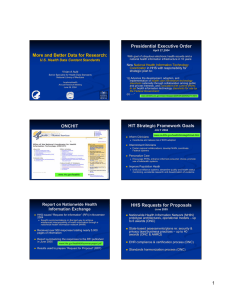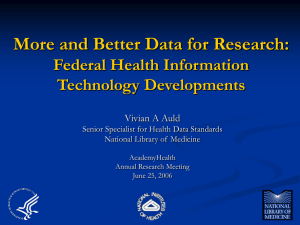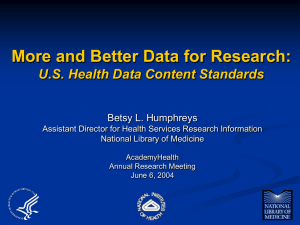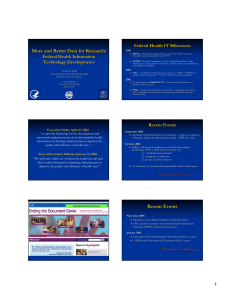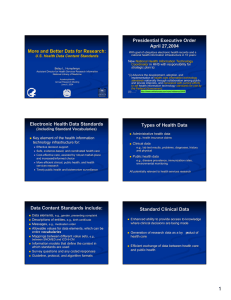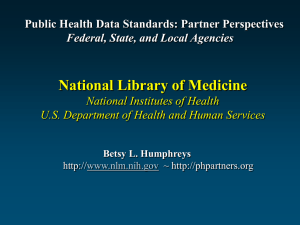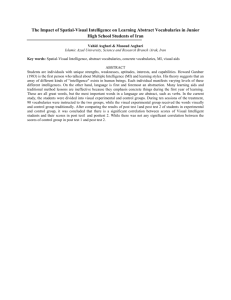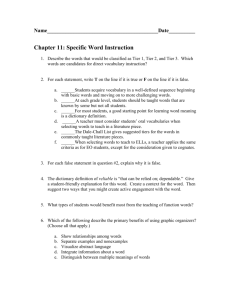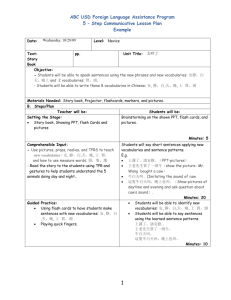More and Better Data for Research: U.S. Health Data Content Standards
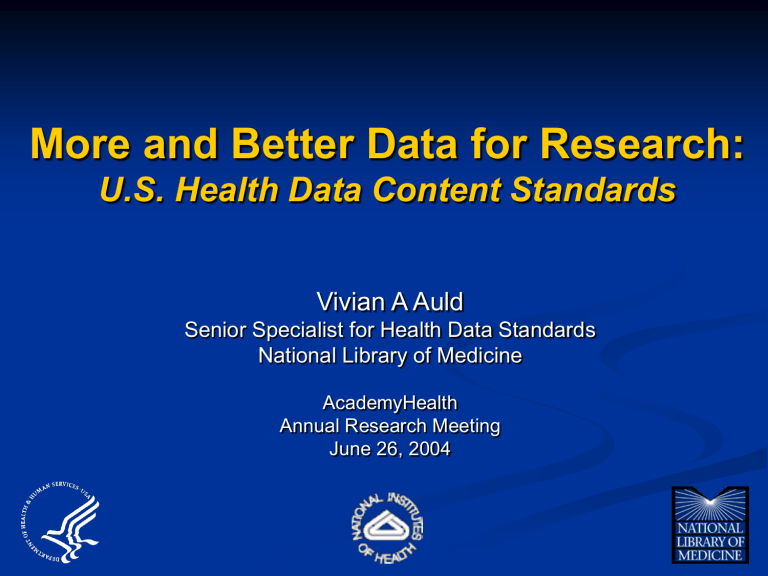
More and Better Data for Research:
U.S. Health Data Content Standards
Vivian A Auld
Senior Specialist for Health Data Standards
National Library of Medicine
AcademyHealth
Annual Research Meeting
June 26, 2004
Presidential Executive Order
April 27,2004
With goal of ubiquitous electronic health records and a national health information infrastructure in 10 years:
New National Health Information Technology
Coordinator in HHS with responsibility for strategic plan to:
“(i) Advance the development, adoption, and implementation of health care information technology standards nationally through collaboration among public and private interests, and consistent with current efforts to set health information technology standards for use by the Federal Government ;
(ii) ….” www.whitehouse.gov/news/releases/2004/04/20040427-4.html
ONCHIT
www.hhs.gov/healthit
HIT Strategic Framework Goals
JULY 2004
www.os.dhhs.gov/healthit/strategicfrmwk.html
Inform Clinicians
Incentivize and reduce risk of EHR adoption
Interconnect Clinicians
Foster regional collaborations, develop NHIN, coordinate
Federal systems
Personalize Care
Encourage PHRs, enhance informed consumer choice, promote use of telehealth systems
Improve Population Heath
Unify surveillance systems, streamline quality and health status monitoring, accelerate research and dissemination of evidence
Report on Nationwide Health
Information Exchange
HHS issued “Request for Information” (RFI) in November
2004
Sought recommendations on the best way to achieve widespread interoperability of health information through a nationwide health information network (NHIN)
Received over 500 responses totaling nearly 5,000 pages of information
Report summarizing the responses to the RFI published in June 2005 www.hhs.gov/healthit/rfisummaryreport.pdf
Results used to prepare “Request for Proposal” (RFP)
HHS Requests for Proposals
June 2005
Nationwide Health Information Network (NHIN) prototype architectures, operational models – up to 6 awards (ONC)
State-based assessments/plans re: security & privacy laws/business practices – up to 40 awards (ONC & AHRQ)
EHR compliance & certification process (ONC)
Standards harmonization process (ONC)
HHS Secretary Leavitt’s 500-Day Plan to
Transform Health Care Systems
Expressing a clear vision of health information technology that conveys the benefits to patients, providers and payers
Convening national collaboration re: developing setting, and certifying
HIT standards and outcomes for interoperability, privacy and data exchange
Realizing the near-term benefits of health information technology in: adverse drug-incident reporting, e-prescribing, lab and claims-sharing data, clinic registrations, insurance forms
Creating an integrated network of population data, genetic information, and medical records to accelerate discovery
Improving the clinical research network
Providing early warning of threats through improved domestic and international surveillance
Congress Drafting Health IT Bills
www.himss.org/Content/files/LegislationCrosswalk-109thcongress.pdf
NLM’s Role in Health Data
Interoperability Standards
Electronic Health Data Standards
(including Standard Vocabularies)
Key element of the health information technology infrastructure for:
Effective decision support
Safe, evidence-based, and coordinated health care
Cost-effective care, assisted by robust market-place and increased/informed choice
More efficient clinical, public health, and health services research
Timely public health and bioterrorism surveillance
Types of Health Data
Administrative health data e.g., health insurance claims
Clinical data e.g., lab test results, problems, diagnoses, history and physical
Public health data e.g., disease prevalence, immunization rates, environmental monitoring
All potentially relevant to health services research
Data Content Standards include:
Data elements, e.g., gender, presenting complaint
Descriptions of entities, e.g., birth certificate
Messages, e.g., medication order
Allowable values for data elements, which can be entire vocabularies
Mappings between different vocabularies
Survey questions and any coded responses
Guideline, protocol, and algorithm formats
Information models that define the context for standards
Standard Clinical Data
Enhanced ability to provide access to knowledge where clinical decisions are being made (e.g. guidelines, decision logic, etc.)
Generation of research data as a by-product of health care
Efficient exchange of data between health care and public health
NLM Long Range Plan
Work with other agencies and organizations to support establishment, maintenance, testing and use of health data standards.
Active partners: Office of the Secretary - HHS, AHRQ,
CDC, CMS, FDA, other NIH components, VA, DoD,
NCVHS, standards development organizations, vocabulary producers, professional associations
Use the UMLS Knowledge Sources and programs to facilitate maintenance and distribution of vocabulary standards.
Federal Standards Selection
Mechanisms
HIPAA (1996)Health Insurance Portability and Accountability Act of
1996 requires administrative standards
NCVHS National Committee on Vital and Health Statistics, a longstanding (50+ years) advisory committee to HHS expanded by
HIPAA, recommends standards
CHI (2001) – Consolidated Health Informatics project, a crossagency eGov initiative designates U.S. gov’t-wide clinical data standards; now part of the Federal Health Architecture
Medicare Modernization Act (2003) - requires e-Prescribing standards; establishes Commission on Systemic Interoperability
Recommended Steps to Achieving
U.S. Health Data Standards (1990-2003)
a
Establish a mechanism for designating U.S. Standards
HIPAA, NCVHS, CHI, MMA
a
Pick best available as starting point NCVHS, CHI
a
Support development, maintenance, and low/no cost distribution – ongoing NLM commitment
Coordinate development of selected standards to achieve non-overlapping, interlocking set
Broaden participation in standards development
Promote use and improvement
Standards Have Been Selected
U.S. National Administrative Standards
HIPAA transactions and code sets www.cms.hhs.gov/hipaa/hipaa2/default.asp
U.S. Government-wide Target Clinical Standards
CHI message and vocabulary standards www.whitehouse.gov/omb/egov/c-3-6-chi.html
U.S. National Public Health Reporting Standards
PHIN (Public Health Information Network) www.cdc.gov/phin/index.html
NLM-led Support for Development and Maintenance
1999 – LOINC (lab tests/instrument observations) - contract support
2002 – RxNorm (clinical drugs) - direct development
2003 – SNOMED CT contract & license for U.Swide use (as distributed by NLM in UMLS)
NLM No-Cost Distribution
umlsinfo.nlm.nih.gov
UMLS
®
Metathesaurus
® a Vocabulary Database
Preserves the meanings , hierarchical connections, and other relationships between terms present in its source vocabularies
Adds certain basic definitional information about each of its concepts
Establishes new relationships between concepts and terms from different source vocabularies
Distributes many vocabularies in a common, explicit format
2005AB UMLS Metathesaurus
(June 2005)
1,196,265 concepts
4,752,383 unique “strings”
(Eye, Eyes, eye = 3)
5,578,532 source vocabulary terms
114 source vocabularies
17 different languages
Other UMLS Resources
Semantic Network
SPECIALIST lexicon
Natural language processing programs
In combination with the Metathesaurus, powerful tools for interpretation/indexing of electronic full text
Letter from HHS Secretary to NCVHS
Sept. 2004
“As you requested …, NLM to serve as the central coordinating body within HHS for
PMRI [Patient Medical Record Information] terminologies. … several … mapping recommendations currently are being implemented by the NLM.”
Coordination means:
Uniform distribution of designated standard vocabularies through the UMLS Metathesaurus
Reducing peripheral overlap and establishing explicit relationships between standard clinical vocabularies (e.g., SNOMED, LOINC, RxNorm)
Aligning standard clinical vocabularies with standard record and message formats
Mapping between standard clinical vocabularies and administrative code sets and/or other important vocabularies
NLM- HL7 Contract Arrangement
Sept. 2004
Align HL7 message standard with standard vocabularies ( NLM-initiated)
Specify which subsets of standard vocabularies are valid for particular message segments
Replace HL7-maintained lists of coded values with subsets of standard vocabularies, where feasible
Create implementation guide(s) for transmitting an entire Electronic Health Record between systems (on behalf of HHS)
Mapping Projects planned/underway
CHI standards – HIPAA code sets
SNOMED CT - ICD-9-CM, ICD-10-CM
SNOMED CT – CPT
LOINC – CPT
SNOMED CT “other” vocabularies
Medical Dictionary for Regulatory Affairs (MedDRA)
International Classification of Primary Care (ICPC)
Medcin
Will require:
Robust testing/validation
Alignment of update schedules
Draft mappings available in the UMLS Metathesaurus for testing by end of 2005
Key NLM Assumptions about Mappings
Participants must include:
Producers of vocabularies on both ends; prospective users and recipients of the output, e.g., health care providers, payers, as testers and validators
Mapping may/will prompt changes/corrections to content and adjustment to update schedules
Mappings must be updated every time either end is updated
Mappings will be distributed in the UMLS (not exclusively); use will be governed by terms applicable to both ends
Mapping is still an R & D problem - it will take iteration to build highly functional maps
Accelerate Adoption and Use
Promote testing use of standards by Federal partners, grantees, and contractors
CDC’s Public Health Information Network (PHIN)
( www.cdc.gov/phin )
NIH emphasis on use in clinical research networks
Encourage manufacturers to include standard identifiers (e.g., LOINC) in device output/test kit packaging
Collaborate with other HHS agencies to support demonstration/testing
Broaden participation: Public Health
www.phdatastandards.info
Broaden participation: Clinical Research
nihroadmap.nih.gov
Strategy for Adoption and
Implementation of Standards
www.nlm.nih.gov/csi/csi_home.html
Commission on Systemic Interoperability
Members
-
appointed late 2004
Scott Wallace , JD, Chair,
National Alliance Health IT
Herbert Pardes , M.D., Pres. &
CEO, NY-Presbyterian Hosp
Simon Cohn , M.D, Kaiser
Don Detmer , M.D., Pres & CEO,
AMIA Ivan Seidenberg , Chm. & CEO,
Verizon of NY
Vicki Gregg , CEO, BlueCross
BlueShield TN Frederick Slunecka , CEO,
Avera McKennan Hosp
Gary Mecklenberg , Pres. &
CEO, Northwestern Memorial
Healthcare
Bill Stead , M.D. Assoc. Vice
Chancellor for Health Affairs,
Vanderbilt
C. Martin Harris , MD, CIO,
Cleveland Clinic
Thomas S. Priselac , Pres. &
CEO, Cedars-Sinai
privacyruleandresearch.nih.gov
Take Home Messages
Health data standards have “arrived”; electronic health records are arriving
Both will affect health care, public health functions, and the data available for HSR
It’s not too early ( or too late ) to get involved:
to contribute to standards development, testing, and refinement
to study the impact of standards on health care, public health, and clinical research
If you work with electronic data, the UMLS resources might be helpful
